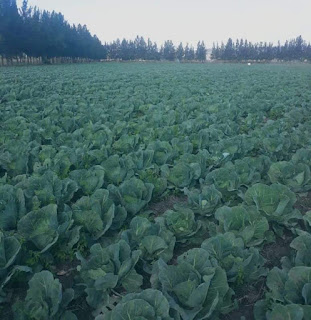FARMERS: don't apply any fertilizer before you read this!!!
Chemical fertilizers have aided farmers in increasing crop production since the 1930's. While chemical fertilizers have their place increasing plant nutrients in adverse weather conditions or during times when plants need additional nutrients, there are also several harmful effects of chemical fertilizers. Some of the harm chemical fertilizers may cause include waterway pollution, chemical burn to crops, increased air pollution, acidification of the soil and mineral depletion of the soil.
1. Waterway Pollution
The use of chemical fertilizers on
crops can have adverse effects on waterways caused by chemical run off of the
excess fertilizer. The over-abundance of nutrients in the water reduces the
amount of oxygen. The existing organisms living in the water use up the oxygen
that is left. The result is oxygen depletion causing the fish to die.
2. Chemical Burn
Chemical leaf scorch can cause the plant to wither and die.
Chemical fertilizers are high in
nutrient content such as nitrogen. Over-application of chemical fertilizer to
plants may cause the leaves to turn yellow or brown, damaging the plant and
reducing crop yield. This condition is known as chemical leaf scorch. Leaf
scorch can cause the leaves of the plant to wither and may cause the plant to
die.
3. Increased Air Pollution
Excess nitrogen used in crop
fertilization can contribute to the release of greenhouse gases such as carbon
dioxide and nitrous oxide into the atmosphere. This effect is caused by using a
greater amount of chemical fertilizer than the plants can readily absorb.
According to the National Oceanic and Atmospheric Administration (NOAA) Climate
Monitoring and Diagnostics Lab, excess greenhouse gases trapped in the
atmosphere may be contributing to the increase of land and ocean surface
temperatures.
4. Soil Acidification
Clay soil buffers excess chemical
fertilization better than others.
The over-use of chemical fertilizers can lead to soil acidification because of a decrease in organic matter in the soil. Nitrogen applied to fields in large amounts over time damages topsoil, resulting in reduced crop yields. Sandy soils are much more prone to soil acidification than are clay soils. Clay soils have an ability to buffer the effects of excess chemical fertilization.
5. Mineral Depletion
Increasing chemical fertilizers can deplete the soil of essential nutrients.
There is an increasing concern that continuous use of chemical fertilizers on soil depletes the soil of essential nutrients. As a result, the food produced in these soils have less vitamin and mineral content. According to data produced by the U.S. Department of Agriculture Nutrient Data Laboratory, foods grown in soils that were chemically fertilized were found to have less magnesium, potassium and calcium content.
...BUT WAIT
THERE IS THE SOLUTION
one that will double or even tripple your harvest this farming season
Chemical Fertlizer Companies FEAR this NEW type of fertilizer.
SASA NUTRIPLANT ORGANIC FERTILIZER
🌱SASA NOPF is a liquid ORGANIC fertilizer that is composed of both micro and macro nutrients in small
molecules of amino acids, peptides, chitosan chelate and their chelates with
trace elements. Predominantly a top dressing.
🌱The fertilizer is non poisonous,
non-toxic and safe for the environment providing our crops with various
nutrients .
🌱The fertilizer promotes the growth of
the plant roots, stems, and leaves, also improves the qaulity and flavor of the
harvestable parts of crops significantly, enhances drought resistance,
infertility resistance, disease and insect pest resistance of the plants, helps
the seeds germinate faster and stronger.
🌱The fertilizer also improves the soil
and enhances bio activity of the soil.
FEATURES OF SASA FORLIAR
FERTILIZER
🌱It is 100% Organic:- it contains all
the macro and micro nutrients in amino acids, chelates, peptides,
gluco-fructo-oligo-sacharides forms a plant requires to grow optimally .
🌱It is non-poisonous:- it is safe for
humans, animals and the environment
🌱Quick Germination:- It increases the
germination rate.
Promotes
the rapid growth of plant roots, stems and leaves.
🌱Crop Immunity:- Enhances the general
immunity of crops to be resistant to drought, infertility, and diseases and
bearing a repellent effect to pests and ar 5thropods.
🌱Improves soil fertility:- Improves the
soil and enhance the bio activity of the soil boosting its fertility.
Promotes
the expansion of the leaf area and increase the photosynthetic rate.
🌱 Competent price- SASA NOPF is affordable, as well as portable
,cutting costs like transportation & warehouse, giving the farmer good
return per dollar on investment for sustainable agribusiness.
2
Litre covers 1 hactare per crop season.
The
dilution ratio is 400mlSasa:200LitresWater per hactare, spray × 5 split
applications . (2ml:1L)
Dosages
may be increased depending on the soil status and/or time of introducting Sasa
to the crop (size).
On
light feeders 1Litre Sasa is enough for a hectare.
Precautions.
❗Shake well before dilution.
❗Dilute/mix well in a separate
container, not in Knapsack.
❗Use hollow cone nozzle. (mist)
❗Do full cover spray ie. leaves &
stems.
❗Spray early morning, dusk or when overcast. Never when it’s hot
BENEFITS OF SASA ORGANIC FERTILIZER
1. DOUBLES YIELD PER HECTARE
2. GREANER, HEALTHIER AND STRONGER PLANTS
3. PROMOTES HEALTHY SYMBIOSIS
4. RICHER SOIL
5. BOOSTS FLOWERING AND SUBSEAQUENTLY MORE GRAINS, COBS OR PODS PER PLANT
6. IT IS COST EFFECTIVE THEREFORE REDUCES PRODUCTION COST
7. INCREASES PROFIT MARGIN FOR OUR FARMERS
ONLY 325 UNITS LEFT AT THIS PRICE!!!
For more information on SASA Nutriplant Organic Foliar Fertilizer & PLACING SASA ORDERS:-
☎️+263771125652
(Mr Mandigora)
Or
Visit us at
No.
75 Robert Mugabe Road; between Angwa & First Street, next to Chuckers
Furniture (Opposite Herentals College)
WaSASA
Wapasa✅









Comments
Post a Comment